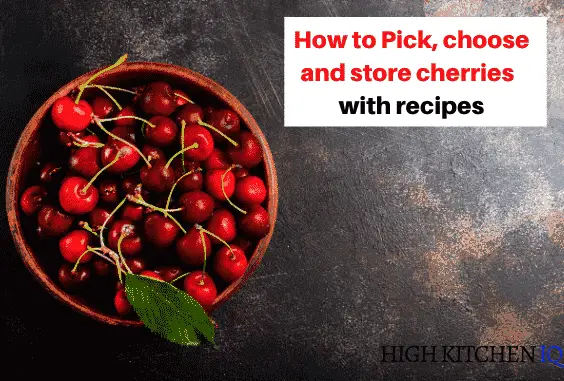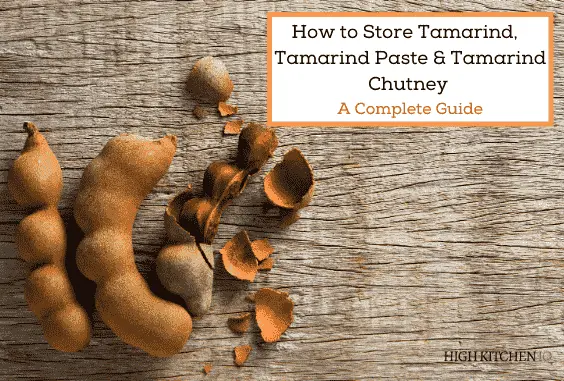How to Properly Pick, Choose, Store & Pit Cherries W/ Tasty Recipes

I absolutely love cherries so much so, that I have a cherry tree planted in my backyard.
And in this article, I hope to guide you on how to select and store cherries properly.
What are Cherries
A cherry is the fruit of many plants of the genus Prunus and is a fleshy stone fruit. Citation.
If you have never seen a cherry, it is a small, round, yellow to deep blackish-red juicy fruit.
Types of Cherries & What Do They Taste Like
Cherries usually fall into two categories either sweet or tart. Traditionally sweet cherries are eaten as they are while tart cherries are cooked in different recipes.
There are many varieties of cherries with each differing in size and flavor.
The more familiar cherry varieties include the black stone cherry, Morello and Spanish cherry.
All cherries have a seed in the middle which cannot be eaten and must be taken out before eating or cooking.
How to Choose Ripe Cherries
If you’re planning on eating cherries raw look for the sweet variety of cherries.
Sour or tart cherries are more suited for pie filling or cooking.
Whether you want sweet cherries or tart cherries, it is best to get them ripe. The best place to get fresh cherries is at a farmer’s market or cherry orchard/ farm.
Cherries, unlike other fruits, do not ripen after picking. Once picked the ripening process is stopped so it is best to pick cherries at their peak.
Here are some tips for choosing ripe cherries:
- The most common cherry varieties will stay in the range of 1 inch (2.5 cm) around when ripe. There are a few varieties of cherries that might get a little larger but the size of a quarter is the standard size for ripe cherries. Smaller cherries will usually not be ripe yet.
- Usually, the darker the red the riper the cherry will be. Some cherries vary so if you are visiting a cherry farm find out from the farmer about the color of the variety you are picking for example Rainiers cherries are yellow even when ripe.
- Gently check the texture of the cherry. The cherry should be firm, not squishy. They should also be smooth, unblemished and glossy to the touch.
- It’s a good idea to sample the cherry if possible by tasting one or two to see if that is the favor you like.
- Sweet cherries tend to keep their stem better than tart cherries.
- If the cherries you are looking at do have stems, check their color. Bright green stems will indicate the cherry’s freshness and health. If a cherry stem is brown or rotted, it is a good indicator that the fruit itself might also be rotted.
Why Cherries Don’t Ripen after Picking Them
Most fruits can be categorized as either climacteric or non-climacteric. The difference between the two is that Climacteric fruits continue to ripen after been harvested while the non-climacteric fruits stop ripen as soon as they are harvested.
Cherries are non-climacteric fruits because they will not ripen once they are picked from the tree. This is because there is no spike in ethylene and CO2 levels in the cherries as they ripen.
Most Climacteric fruits will ripen when also exposed to ethylene but this has no effect on non-climacteric fruits like cherries.
Because of this, the fruit must be ripe at the time it is picked. Some other non-climacteric fruits other than cherries are citrus fruits, grapes, watermelon, and bell peppers.
Tips When Going to Cherry Picking on a Cherry Farm or Orchard
If you are going to pick cherries from a farm or orchard, follow these rules for a perfect cherry-picking.
- Firstly if you are visiting a cherry farm or orchard, it is a good idea to call ahead for information about the variety of cherries available and the ripeness of the cherry.
- Usually, sweet cherries will ripen first in the Summer followed by the tart ones 3 weeks later.
- Dress in comfortable clothing and wear sunscreen.
- Walk with a cooler if and some perforated food bags to allow your cherry to get better ventilation. This is perfect for if the orchard is a long distance away from your home.
- Once at a cherry orchard or farm talk to the owner or farmers there.
- Seek their advice and ask them about the cherry variety offered at the farm and the suitability of the cherry variety with for what you intend to use your cherries for e.g eating or baking.
How to Pick Cherries from a Tree
- Cherry trees often have large leaves so the fruit might be covered.
- So you are gonna have to move the leaves of the cherry tree around to find ones that may be hidden from direct view.
- Always inspect the cherries for signs of damage or defect before plucking it.
- Decide on whether you will like to pick the cherry with a stem or cherry without the stems.
- Cherries without stems have to be eaten quickly because they will spoil easily, while cherries with a stem will last a long time.
- After you have made your choice of which cherry to pick.
- You need to grasp the stem of the ripe cherry and pull in an upwards motion removing the cherry with the stem from the tree. Don’t grab it too hard, or you might damage the fruit.
- Repeat this process of grasping the cherry with your forefinger and thumb, and gently pull it off of the tree, until your hand is full with cherries then place the cherries into the container. This will allow the cherry picking to go much quicker.
- If the cherry comes off of the stem in the process, don’t worry. The cherry is still edible just eat the stemless cherries first because they will spoil first.
- You can use a basket, plastic container or bucket to pack your cherries. Don’t force the fruit into the container or try to pack them down, as this could damage your cherries.
- Finally, once your container is filled with the cherries, move them out of the sunlight in a shaded cool area so they will last longer.
- The exposure to excess heat will shrink and wrinkle the cherries which will sap their flavor.
How to Store Cherries For Short Term
When storing cherries it is important to put them into a fridge as soon as possible. They are a pretty sensitive fruit and they lose their taste in room temperature environments.
Cherries also absorb water when rinsed so don’t wash them until you are ready to eat them or bake with them.
If you want your cherries to last longer store the unwashed cherries between layers of paper towel in a resealable plastic bag or an airtight container in the refrigerator.
Stored correctly, cherries will last for around a week in the fridge. If you want to keep them longer, consider freezing the fruits in airtight plastic bags.
If you keep cherries at room temperature, then you should be prepared to eat them as soon as possible because the cherries will only be good for up to 2 days. Make sure to wash and dry all cherries before eating.
How to Freeze Cherries
- Wash the cherries and pat them dry completely using paper towels or kitchen towels. Be gently and try to avoid damaging the cherries.
- Remove the cherry stems, and pit the cherries (Continue reading below to find out my best cherry pitting methods).
- Spread the cherries out evenly on a baking sheet lined with parchment paper. This will help prevent them from sticking, so make sure you use it. You should also leave space between the cherries so that they don’t stick to each other.
- Put the baking pan in the freezer until the cherries are completely frozen. This may take a few hours, once they are frozen, transfer them to an airtight bag or container, and label it.
- Finally, you can store it in the freezer.
The Best Ways to Pit Cherries
There are many ways to remove the pit or seed from a cherry. You can use a:
- Cherry Pitter
- Paper Clip
- Chopstick
- Sturdy Straw
- Pastry tip
- Paring knife and cutting board
- The Garlic Method
1-Cherry Pitter
A cherry pitter is a device is used for removing the pit from a cherry, leaving the cherry relatively intact. There are many kinds of cherry pitters, including small tools held in the hand, domestic crank-operated machines with a hopper, and industrial machines for large scale businesses.
Most cherry pitters work by first removing the stem, then driving a plunger through the cherry in a way that the stone is ejected out the other side of the fruit.
2- Paper Clip
Unfold the paper clip, insert one end into the cherry, and dig around the pit until it pops out.
3- Chopstick
Push a chopstick through the stem end of the cherry, and the pit will shoot out on the other side.
4- Sturdy Stiff Straw
Push a sturdy stiff straw through the stem end of the cherry and the pit will come out the other side.
5- Pastry Tip
Place a pastry tip with the tip-side up on your work surface and push the cherry firmly on it until the pit comes out of the other end
6- Paring Knife
Get a paring knife and using a cutting board to gently cut around the cherry pit and dig it out using the knife tip.
7- Garlic Method
Using a cutting board and a knife, place the cherry on the surface of the board. Use the flat side of the knife to apply pressure on the cherry until the pit pops out.
This method is similar to the one used for removing garlic from its skin. It should not be used when you want the cherry to be intact.
Some of My Favorite Cherry Recipes
Cherry Juice Recipe
Ingredients
- 2 cups tart cherries
- 2 cups water
- 1/2 cup granulated sugar
- 1 cup cubed watermelon
- 1 tbsp ginger chopped
- cup ice
Method
- Wash the cherries with cold tap water and then place them into the blender or food processor.
- Add the chopped ginger,watermelon, sugar and water to the cherries and blend for two minutes or until smooth.
- Strain the drink using a strainer into a clean mug or pitcher.
- Refrigerate until cold or add ice and serve immediately.
Mini Cherry Pies Recipe
Ingredients
- 1 lb. fresh tart cherries pitted
- 1/4 cup water
- 1 tsp lemon juice
- 1/4 cup sugar plus 1 tsp for sprinkling
- 2 tbsp cornstarch
- Nonstick spray or butter for pan
- 1/2 Tsp Almond Extract
- 1 package refrigerated pie crust
- 1 tbsp. milk
Tools and Equipment
- Rolling Pin
- Muffin Tin/ Pie Maker Machine
- Dough cutter/Glass Cup
You can find out all about Pie Maker Machines and what to look for when purchasing one By Reading my Article The Ten Best Pie Maker Machines
Method
How to make the filling
- In a saucepan on medium heat, add cherries, water, lemon juice, almond extract, sugar, and cornstarch.
- Reduce heat to low and cook and simmer for 15 minutes or until the cherries lose considerable juice .
- If the filling is too thick, add a little water, too thin, add a little more cornstarch.
How to assemble the Cherry Pie
It is not mandatory to use store bought pie crust you can make your own if you wish.
- First, you are gonna need to get a Pie cutter or if you don’t have one substitute by using the rim of a glass to cut large circles into pie crust (they should be big enough to line the whole muffin cup or pie maker pocket).
- Next press the crust into the muffin tins or pie maker pocket depending on what equipment you are using and up the sides.
- Then spoon over filling into each until they are full.
- Roll out the remaining scraps of the left over pie crust and slice into decorative strips with a pizza cutter or knife.
- Make a decorative pie crust using the strips on top of the pie.
- Trim the ends of the overhanging pie crust. Brush the top of the pie with milk and sprinkle with the remaining sugar.
- Bake at 350 for 23 minutes in a muffin pan or 15 minutes in a pie maker.
The time may vary depending on the type of pie maker used.
Health benefits of cherries
- Cherries are a super food filled with antioxidants and loads of vitamins, fiber and minerals.They are a good source of vitamin C, potassium, fiber, and other nutrients that your body needs to function healthily.
- All cherries are high in antioxidants and anti-inflammatory compounds, this can help lower the risks of chronic disease.
- Eating cherry products like cherry juice may help athletic performances and lower the chance of having exercise-induced muscle damage and soreness.
- Cherries are also loaded with potassium and polyphenol antioxidants, which contain heart-protective properties.
- Researchers have stated that the powerful anti-inflammatory properties that cherries have may improve the conditions of arthritis and gout.
- The anti-inflammatory compounds and melatonin found in cherries can help improve sleep quality in some people.





